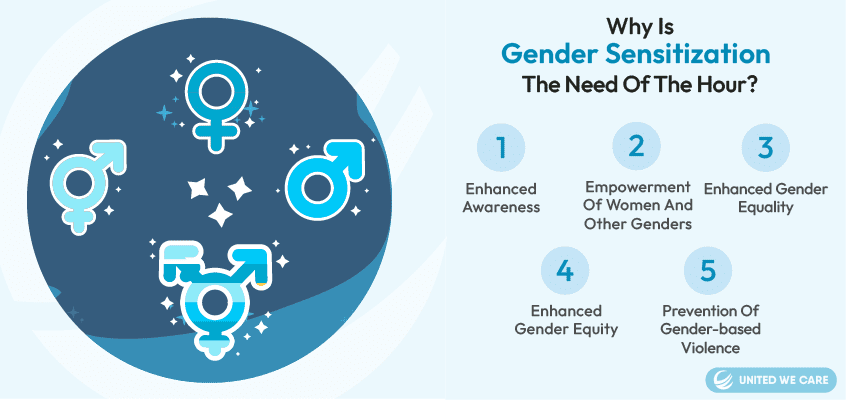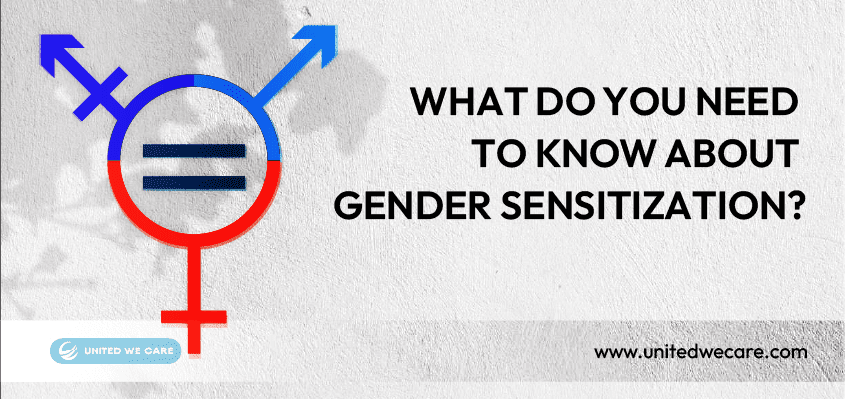Introduction
Have you heard of something called the pink tax? Or this term called glass ceiling effect? And do you know that in many countries, women’s education is still a taboo? The history, practice and effects of gender discrimination are many. Most countries consider women to be lesser than men. Further, people of other gender identities are not even recognized or given basic rights. The result? There is widespread violence, bias, and discrimination against some genders. This issue is so prevalent that the the United Nations ended up selecting Gender Equality as one of its Sustainable Development Goals [1]. One way to reach this equality is Gender sensitization. This article delves into the meaning of gender sensitization and attempts to answer why it is the need of the hour.
What is Gender Sensitization?
Gender related issues are prevalent across the world. Even though many women and men fight for equality, very few people actually understand these issues. To increase awareness, Gender sensitization is a process taken up by governments and institutions to develop understanding, and empathy toward gender-related issues [2]. Using campaigns, workshops, training programs, and other educational or procedural techniques, individuals are encouraged to examine their own beliefs, attitudes, and behaviors toward people of different genders [2].
Before getting into the reason and importance of gender sensitization, it is essential to understand two key concepts. The first is sex. When human beings are born, society assigns them a sex based on their biology. These include male, female, or intersex. However, sex is limited to biology. The second concept, gender, comes into the picture when culture assigns these individuals specific roles and gives them rules to behave. For instance, a child assigned female at birth must have long hair or can wear a dress are rules defined by the society.
In the 1970s, Ann Oakley and her colleagues popularized this distinction and talked about how societal norms towards the role of men and women are not fixed. These attitudes, beliefs, and expectations are cultural and can transform as cultural, social, economic, and political factors change [2]. For example, in the US, a woman’s expected clothing can be a dress, whereas in India, it can be a saree. In other words, after Oakley’s work, authors and researchers began to recognize gender as a social construct.
Traditionally, most societies have carried the mindset that men and women are “unequal entities,” with women being the less able gender [3]. Societies that ascribe to the traditional patriarchal worldview consider men as authority figures, and women’s rights are curbed, leading to their oppression [4]. Various sources have linked this ideology to violence against women [1]. Further, traditional views on gender have also excluded various minority communities like transgenders and curbed their rights.
Sensitization is an effort to rectify the effects of these norms and promote an egalitarian and inclusive society.
Must read – Gender Identity and Sexual Orientation
Where is Gender Sensitization Required?
Gender discrimination is the sad reality of various spheres of life, including healthcare, education, workplace, and legal rights. For instance, the recent debates and protests on the rights of transgender individuals are an extension of gender discrimination and biases that people possess [5]. Thus, gender sensitization is a pertinent requirement in various arenas of life. Specifically, the areas that require it are:
- Education: Since children begin developing their gender identity and begin to understand their roles when they are in school, gender sensitization at a school level can be immensely beneficial. Adding it to the academic curriculum of schools, colleges, and universities can help children understand the unique experiences, challenges, and requirements of individuals based on their gender, as well as inculcate respect for all people [6].
- Workplace: Stereotypes, biases, toxic masculinity, exclusion, and pay gaps are some examples of problems that women face in workplaces [7]. Others, such as transgender individuals, also face discrimination in the process of hiring. Workplace sensitization is crucial for ensuring equal treatment and opportunities for employees of all genders.
- Healthcare Industry: The Health needs of different individuals are different. Individuals of different genders may experience varying health risks, symptoms, complaints, and diseases. The medical community needs to start recognizing this fact and implementing gender-sensitive protocols, policies, and education [8].
- Legal and Justice Systems: Gender sensitization is vital within legal and justice systems. Often, women and other genders are discriminated against and treated unfairly when it comes to filing complaints and acquiring justice. Sensitizing judges, lawyers, and law enforcement personnel to discrimination and the unique challenges faced by marginalized gender groups can address these challenges.
- Media and Entertainment: Traditionally, media and entertainment have built on stereotypes and excluded various genders from being represented appropriately. Many tropes, such as manic-pixie dream girls, showing trans individuals as mentally unstable and men as hyper-masculine, have caused great harm. Gender sensitization in media and entertainment industries can help mainstream gender, remove harmful stereotypes, and change societal attitudes at large [9].
Must read- Gender Discrimination
Why is Gender Sensitization the Need of the Hour?
Gender sensitization can help the world reach this position envisioned by the UN. A world where people are equal.
Sensitization efforts can lead to [3] [6] [10] [11]:

- Enhanced Awareness: Increased awareness about the social construction of gender, gender roles, and the unique experiences and challenges different genders face results from gender sensitization. Such concepts can help individuals uncover their biases and change their perceptions of different genders.
- Empowerment of Women and Other Genders: With gender sensitization, marginalized groups, including women and transgender individuals, can obtain skills, knowledge, and attitudes that can help them promote gender equality. Further, men can understand their privileges and join the cause of gender inclusion, challenge gender norms, and contribute towards the overall integration of women and minorities in different spheres of life.
- Enhanced Gender Equality: Gender sensitization helps people understand and assert their rights, which includes an enhanced demand for equality. A patriarchal culture would promote unequal power dynamics, discrimination, and stereotypes, but through gender sensitization, this can be negated.
- Enhanced Gender Equity: Equitable distribution of resources focuses on ensuring fairness and justice in distributing resources, opportunities, and power between genders. Since some genders have faced discrimination and oppression, gender equity will focus on supporting them through policies and procedures (for example, incentivizing the education of girl children).
- Prevention of Gender-Based Violence: Gender inequality is the most common cause of violence against women. Gender sensitization can help in addressing these concerns and promote economic and social empowerment of all genders.
Read more about- Gender Dysphoria
Conclusion
A society which values all people will be a harmonious and peaceful society. Gender sensitization is a process that aims to create a reality where all genders are valued equally. If implemented appropriately in key institutions such as educational institutions, workplaces, healthcare, legal systems, and the media, the goal of creating environments that foster inclusive spaces devoid of discrimination can be achieved.
If you are an organization in need of gender sensitization programs, you can connect with our experts at United We Care. Our professionals can provide your organization with training solutions and enhance inclusivity and equality within your institution.
References
- “Gender equality and women’s empowerment,” United Nations, https://www.un.org/sustainabledevelopment/gender-equality/ (accessed Jul. 18, 2023).
- C. R. L. Kalyani, A. K. Lakshmi, and P. Chandrakala, “Gender: An overview,” in Gender Sensitization, D. S. Vittal, Ed. 2017
- H. K. Dash, K. Srinath, and B. N. Sadangi, ICAR-CIWA, https://icar-ciwa.org.in/gks/Downloads/Gender%20Notes/Gender%20Notes(1).pdf (accessed Jul. 18, 2023).
- S. A. Watto, “Conventional Patriarchal Ideology of Gender Relations: An Inexplicit Predictor of Male Physical Violence against Women in Families,” European Journal of Scientific Research, 2009. Accessed: Jul. 18, 2023. [Online]. Available: https://d1wqtxts1xzle7.cloudfront.net/14786736/ejsr_36_4_07-libre.pdf?1390863663=&response-content-disposition=inline%3B+filename%3DConventional_Patriarchal_Ideology_of_Gen.pdf&Expires=1689699993&Signature=Vy5RFmk3kZypoYMRVP5d~xDIDF6yMAIhjBr37Q3xtmiFelCnTRtC9idU5mRPprhlr~X5UwRch-vS0ILF6nRQmqySp7GW~p6WhkdzvfrxhkCAliAy3BCoWo~hBpl6BiBYbMUqTNDYX~D7F7KkyklRJnwFNQRPnNHDxQKhSzBFN7pIjczOeoDYQPFKlGDuGLe~irgEOpZwZ6sYu5-DIi0PZM-PhYf9fl8PW4xcY3R-sT01p6rlFGO9uYdpyhujFuL4Oyheu8H3pT8HE7M6-YfD3i7n8MvImKz~G3VV-4ZCJyZF5C-YaMzM6aed1q54R6dVpb7eS-67yGKq4MgC798yhA__&Key-Pair-Id=APKAJLOHF5GGSLRBV4ZA
- “The struggle of trans and gender-diverse persons,” OHCHR, https://www.ohchr.org/en/special-procedures/ie-sexual-orientation-and-gender-identity/struggle-trans-and-gender-diverse-persons (accessed Jul. 18, 2023).
- B. P. Sinha, “Gender Sensitisation: Reflections and Observations,” in The Wise Words of Webinars, J. Rathod, Ed. 2021, pp. 18–23
- F. Kapadia, “Gender sensitivity at workplaces – walk the talk,” LinkedIn, https://www.linkedin.com/pulse/gender-sensitivity-workplaces-walk-talk-farzana-kapadia/ (accessed Jul. 18, 2023).
- H. Çelik, Gender sensitivity in health care practices : From awareness to action, 2009. doi:10.26481/dis.20091120hc
- S. Nanjundaiah, “Educating gender-responsible media professionals – linkedin,” LinkedIn, https://www.linkedin.com/pulse/educating-gender-responsible-media-professionals-nanjundaiah (accessed Jul. 18, 2023).
- R. Mittal and J. Kaur, “Gender sensitization for women empowerment: A Review,” Indian Journal of Economics and Development, vol. 15, no. 1, p. 132, 2019. doi:10.5958/2322-0430.2019.00015.5
- Need for gender sensitization | OER commons, https://oercommons.org/courseware/lesson/65970/student/?section=1 (accessed Jul. 18, 2023).





